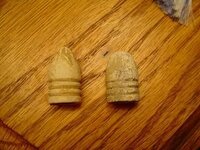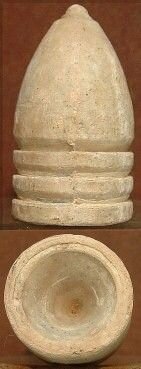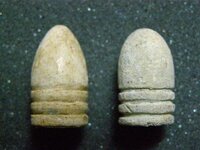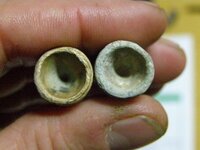BuckleBoy
Gold Member
Hello All!
I do pretty well with CW bullet ID's, but here are two that I've had for a while--I'm stumped.
First one is similar in size to a .58 cal Minieball (Minie on the left, unknown bullet on the right in the photos below). It appears to have a flatter nose than any other Minie I have found, plus there is a little "nipple" on the top of the bullet. This one was dropped, and recovered from a plowed field. The base cavity is cone shaped, but the outer rim of the base is a little more thick than a normal Minie. This is the only one of its kind I have ever found.



The next type of bullet has been a puzzler for over 10 years. I've showed it to some bullet gurus, and no one has been able to give me an ID. .58 cal Minieball is again on the left for size comparison. This one is fired. I have found 30 of these bullets--all at the same site--and all within a 20 square foot area. They were on a hillside interspersed among literally hundreds of fired .58 cal Minies and cleaner bullets at a CW target practice site, so I am absolutely certain that they were fired by the CW troops there. The base of them is flat. Any ideas are much appreciated.



Regards,
Buckleboy
I do pretty well with CW bullet ID's, but here are two that I've had for a while--I'm stumped.

First one is similar in size to a .58 cal Minieball (Minie on the left, unknown bullet on the right in the photos below). It appears to have a flatter nose than any other Minie I have found, plus there is a little "nipple" on the top of the bullet. This one was dropped, and recovered from a plowed field. The base cavity is cone shaped, but the outer rim of the base is a little more thick than a normal Minie. This is the only one of its kind I have ever found.



The next type of bullet has been a puzzler for over 10 years. I've showed it to some bullet gurus, and no one has been able to give me an ID. .58 cal Minieball is again on the left for size comparison. This one is fired. I have found 30 of these bullets--all at the same site--and all within a 20 square foot area. They were on a hillside interspersed among literally hundreds of fired .58 cal Minies and cleaner bullets at a CW target practice site, so I am absolutely certain that they were fired by the CW troops there. The base of them is flat. Any ideas are much appreciated.



Regards,
Buckleboy



 ? I've found several examples that have been rammed but I can see no rifling were it was fired. Then of course there is always the possiblity that it is carved. There are some very extreme examples of civil war carved bullits in the above book. Always get the weight in grams, length, diameter, base type, etc... before trying to identify civil war projectiles. There are thousnad sof examples. Also with the second bullet type if you get the above info for me I may be able to further help. I agree with other posters though. Either carbine or repeater rifle.
? I've found several examples that have been rammed but I can see no rifling were it was fired. Then of course there is always the possiblity that it is carved. There are some very extreme examples of civil war carved bullits in the above book. Always get the weight in grams, length, diameter, base type, etc... before trying to identify civil war projectiles. There are thousnad sof examples. Also with the second bullet type if you get the above info for me I may be able to further help. I agree with other posters though. Either carbine or repeater rifle. 



 Thank's and HH!!
Thank's and HH!!
